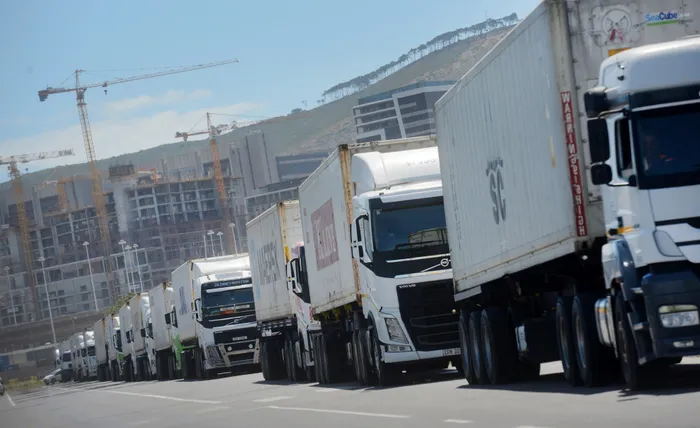New report seeks to tackle logistics logjams

Trucks carrying containers queue outside the container depot at the Port of Cape Town in December, 2023. Picture: Armand Hough/Independent Newspapers
Nicola Mawson
Data coming out of a new Pulse Report, under the auspices of the government-initiated national logistics crisis committee (NLCC) that will track logistics logjams will provide weekly statistics so that obstacles affecting South Africa’s logistics network can be identified, and the results of interventions tracked.
The report’s launch comes against the backdrop of Transnet implementing a turnaround plan that aims to enhance competitiveness of its ports, recover rail volumes, and improve operating efficiency at ports, among other aspects. In addition, it has been released at a time when South Africa’s roads are characterised by a lack of maintenance and many potholes.
The NLCC was established by the Presidency under Operation Vulindlela in 2023 to address the state of logistics in South Africa, which was costing the country around R1.5 billion per day. The government works together with business and social partners.
Jayce Lane, managing director of Crickmay & Associates, which compiled the report, explained at the launch that it was important to understand how the logistics network is affected because supply chain corridors’ competitiveness is impacted by how well they operate.
Lane said the report aimed to get to one single truth and not work on hearsay but on established data, which makes a “great basis for work going forward”. The information would enable stakeholders to identify and address obstacles, as well as then being able to determine the impacts that the changes make, he said.
The Pulse Report considered data obtained from eight major corridors as well as all ports and border posts. The data was gleaned from 80 million heavy motor vehicles records a day, which was anonymised, as well as about 150 000 records a week covering all vessels moving in and out of the country’s ports, which includes the time they spend there.
The eight major corridors are:
∎ N1 Corridor Cape Town/Beitbridge
∎ N2 Corridor Ermelo/Richards Bay
∎ N3 Corridor Durban/Johannesburg
∎ N4 Corridor Pretoria/Maputo
∎ N8 Corridor Bloemfontein/Nakop
∎ Kuruman/Saldanha Bay
∎ Kuruman/Gqeberha
Walvis Bay/Cape Town
Lane said, as an example, the data indicated that week-on-week traffic between Kuruman and Gqeberha was just more than a fifth slower last week, which is about the same extent to which the N3 from Johannesburg to Durban slowed down. However, he pointed to the fact that the data also highlighted the fact that the Walvis Bay to Cape Town route is 16% quicker.
“In a snapshot, you get a good sense just how the corridor has been performing over the week that compares with the previous reading,” Lane said. He added that the report also included information on border queues, which allowed stakeholders to determine whether the wait time had improved.
Simultaneously, said Lane, it was important that the industry self regulates and tries to promote accountability between parties. “Any port or any border process is a shared resource and, depending on how well we use that shared resource collectively, will determine how effective those ports, borders or corridors will be. And that’s important,” he said.
Dr Juanita Maree, CEO of the Southern African Association of Freight Forwarders, said the initiative was vital because of the burden of logistics costs on the economy.
“The additional expenses incurred due to the inefficiencies at ports and border posts, along with the deteriorating rail and road infrastructure, present a significant challenge to the sustainability of the logistics sector,” Maree lamented.
“This situation also places South Africa’s competitive standing in the global market at risk, with the possibility of import and export freight being diverted to more efficient routes, which could have considerable implications for the national economy,” she said.
BUSINESS REPORT